check engine FIAT DOBLO 2008 1.G User Guide
[x] Cancel search | Manufacturer: FIAT, Model Year: 2008, Model line: DOBLO, Model: FIAT DOBLO 2008 1.GPages: 222, PDF Size: 3.39 MB
Page 98 of 222
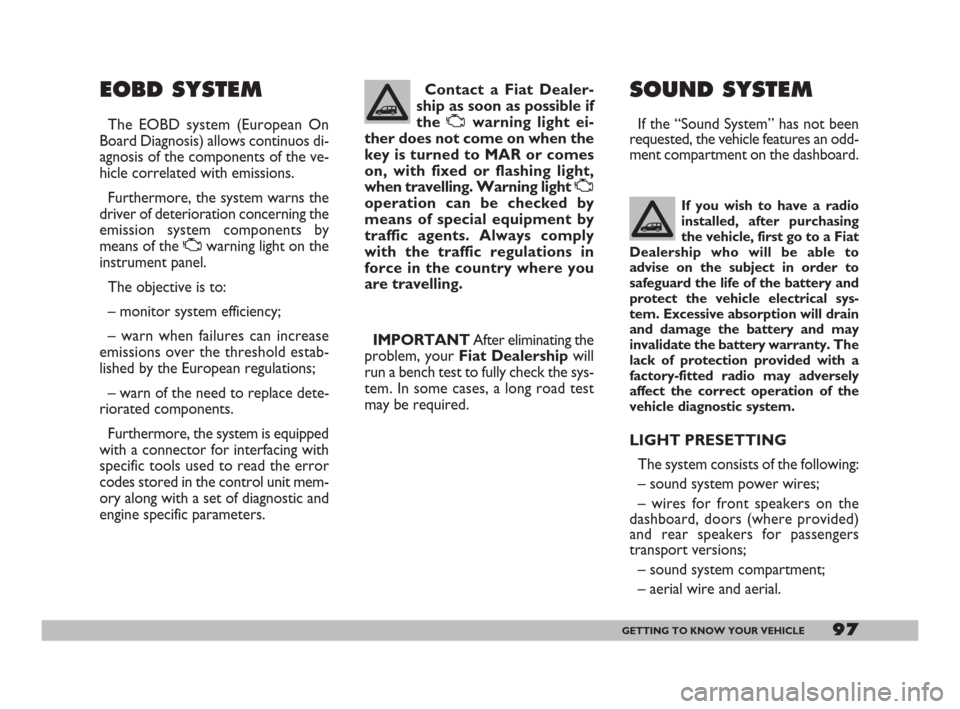
97GETTING TO KNOW YOUR VEHICLE
EOBD SYSTEM
The EOBD system (European On
Board Diagnosis) allows continuos di-
agnosis of the components of the ve-
hicle correlated with emissions.
Furthermore, the system warns the
driver of deterioration concerning the
emission system components by
means of the Uwarning light on the
instrument panel.
The objective is to:
– monitor system efficiency;
– warn when failures can increase
emissions over the threshold estab-
lished by the European regulations;
– warn of the need to replace dete-
riorated components.
Furthermore, the system is equipped
with a connector for interfacing with
specific tools used to read the error
codes stored in the control unit mem-
ory along with a set of diagnostic and
engine specific parameters.IMPORTANTAfter eliminating the
problem, your Fiat Dealershipwill
run a bench test to fully check the sys-
tem. In some cases, a long road test
may be required. Contact a Fiat Dealer-
ship as soon as possible if
the Uwarning light ei-
ther does not come on when the
key is turned to MAR or comes
on, with fixed or flashing light,
when travelling. Warning light U
operation can be checked by
means of special equipment by
traffic agents. Always comply
with the traffic regulations in
force in the country where you
are travelling.
SOUND SYSTEM
If the “Sound System” has not been
requested, the vehicle features an odd-
ment compartment on the dashboard.
If you wish to have a radio
installed, after purchasing
the vehicle, first go to a Fiat
Dealership who will be able to
advise on the subject in order to
safeguard the life of the battery and
protect the vehicle electrical sys-
tem. Excessive absorption will drain
and damage the battery and may
invalidate the battery warranty. The
lack of protection provided with a
factory-fitted radio may adversely
affect the correct operation of the
vehicle diagnostic system.
LIGHT PRESETTING
The system consists of the following:
– sound system power wires;
– wires for front speakers on the
dashboard, doors (where provided)
and rear speakers for passengers
transport versions;
– sound system compartment;
– aerial wire and aerial.
001-105 Doblo GB 16-12-2008 14:22 Pagina 97
Page 111 of 222
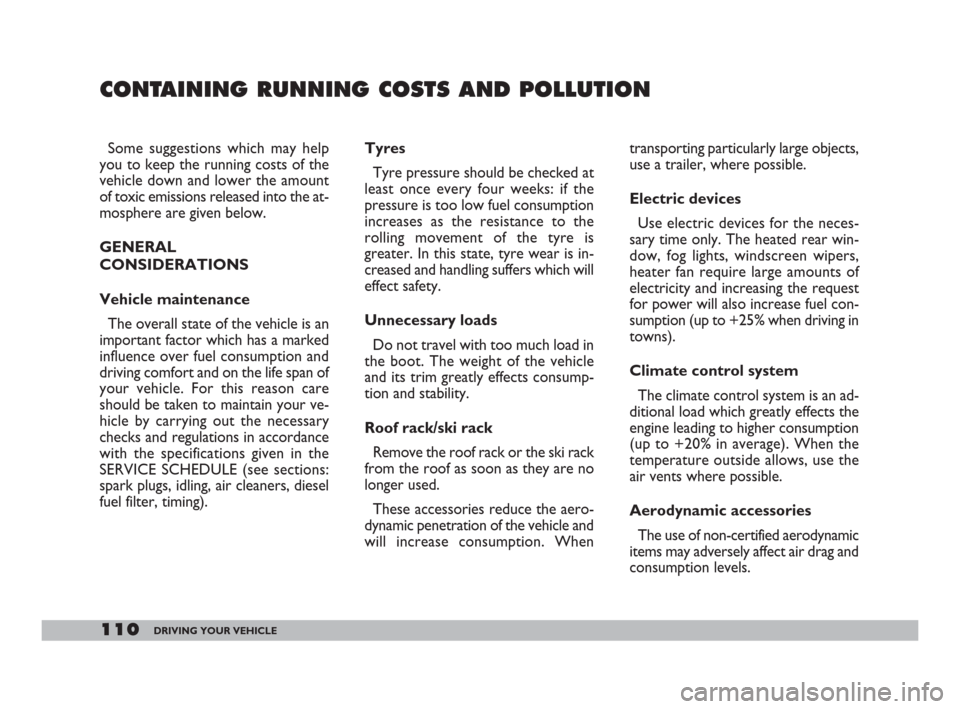
110DRIVING YOUR VEHICLE
Some suggestions which may help
you to keep the running costs of the
vehicle down and lower the amount
of toxic emissions released into the at-
mosphere are given below.
GENERAL
CONSIDERATIONS
Vehicle maintenance
The overall state of the vehicle is an
important factor which has a marked
influence over fuel consumption and
driving comfort and on the life span of
your vehicle. For this reason care
should be taken to maintain your ve-
hicle by carrying out the necessary
checks and regulations in accordance
with the specifications given in the
SERVICE SCHEDULE (see sections:
spark plugs, idling, air cleaners, diesel
fuel filter, timing).Tyres
Tyre pressure should be checked at
least once every four weeks: if the
pressure is too low fuel consumption
increases as the resistance to the
rolling movement of the tyre is
greater. In this state, tyre wear is in-
creased and handling suffers which will
effect safety.
Unnecessary loads
Do not travel with too much load in
the boot. The weight of the vehicle
and its trim greatly effects consump-
tion and stability.
Roof rack/ski rack
Remove the roof rack or the ski rack
from the roof as soon as they are no
longer used.
These accessories reduce the aero-
dynamic penetration of the vehicle and
will increase consumption. Whentransporting particularly large objects,
use a trailer, where possible.
Electric devices
Use electric devices for the neces-
sary time only. The heated rear win-
dow, fog lights, windscreen wipers,
heater fan require large amounts of
electricity and increasing the request
for power will also increase fuel con-
sumption (up to +25% when driving in
towns).
Climate control system
The climate control system is an ad-
ditional load which greatly effects the
engine leading to higher consumption
(up to +20% in average). When the
temperature outside allows, use the
air vents where possible.
Aerodynamic accessories
The use of non-certified aerodynamic
items may adversely affect air drag and
consumption levels.
CONTAINING RUNNING COSTS AND POLLUTION
106-118 Doblo GB 9-05-2008 12:09 Pagina 110
Page 119 of 222
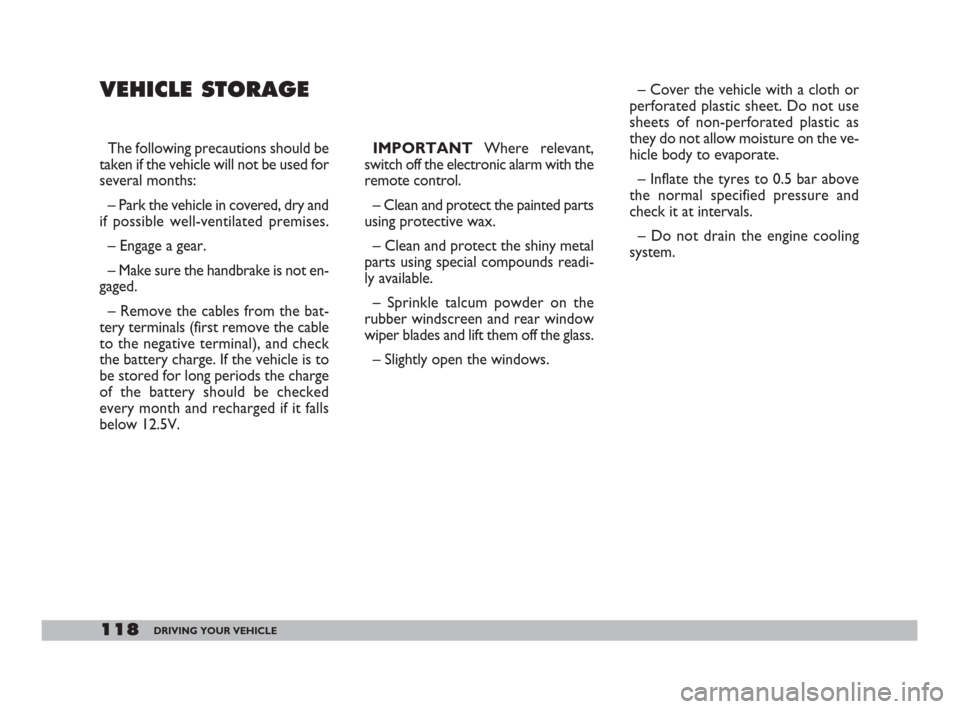
118DRIVING YOUR VEHICLE
The following precautions should be
taken if the vehicle will not be used for
several months:
– Park the vehicle in covered, dry and
if possible well-ventilated premises.
– Engage a gear.
– Make sure the handbrake is not en-
gaged.
– Remove the cables from the bat-
tery terminals (first remove the cable
to the negative terminal), and check
the battery charge. If the vehicle is to
be stored for long periods the charge
of the battery should be checked
every month and recharged if it falls
below 12.5V.IMPORTANT Where relevant,
switch off the electronic alarm with the
remote control.
– Clean and protect the painted parts
using protective wax.
– Clean and protect the shiny metal
parts using special compounds readi-
ly available.
– Sprinkle talcum powder on the
rubber windscreen and rear window
wiper blades and lift them off the glass.
– Slightly open the windows.– Cover the vehicle with a cloth or
perforated plastic sheet. Do not use
sheets of non-perforated plastic as
they do not allow moisture on the ve-
hicle body to evaporate.
– Inflate the tyres to 0.5 bar above
the normal specified pressure and
check it at intervals.
– Do not drain the engine cooling
system.
VEHICLE STORAGE
106-118 Doblo GB 9-05-2008 12:09 Pagina 118
Page 123 of 222
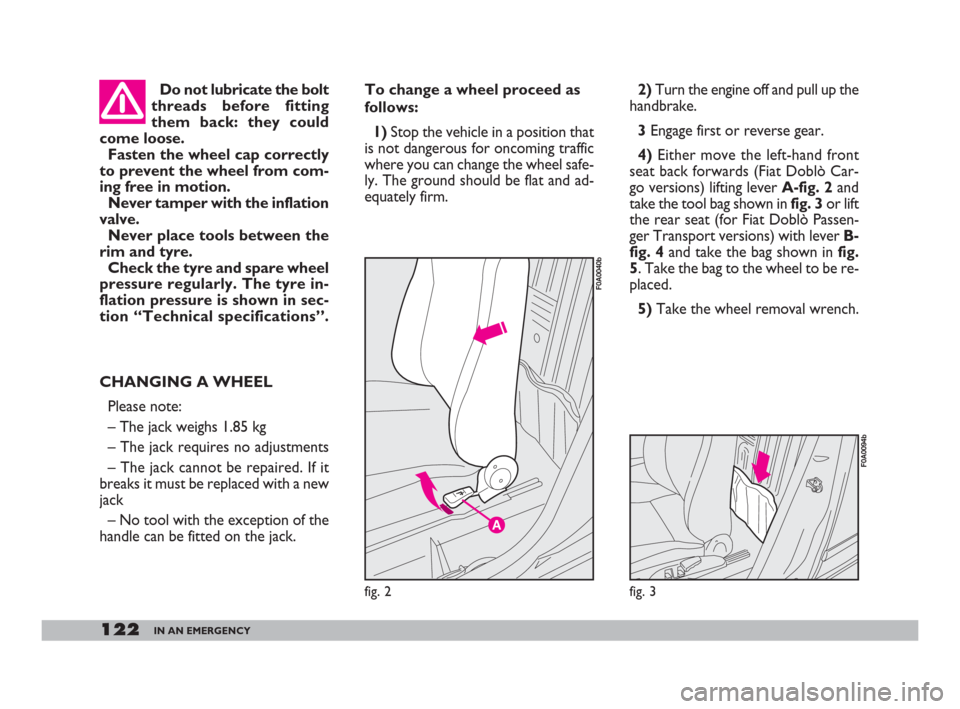
122IN AN EMERGENCY
To change a wheel proceed as
follows:
1)Stop the vehicle in a position that
is not dangerous for oncoming traffic
where you can change the wheel safe-
ly. The ground should be flat and ad-
equately firm. Do not lubricate the bolt
threads before fitting
them back: they could
come loose.
Fasten the wheel cap correctly
to prevent the wheel from com-
ing free in motion.
Never tamper with the inflation
valve.
Never place tools between the
rim and tyre.
Check the tyre and spare wheel
pressure regularly. The tyre in-
flation pressure is shown in sec-
tion “Technical specifications”.
CHANGING A WHEEL
Please note:
– The jack weighs 1.85 kg
– The jack requires no adjustments
– The jack cannot be repaired. If it
breaks it must be replaced with a new
jack
– No tool with the exception of the
handle can be fitted on the jack.2)Turn the engine off and pull up the
handbrake.
3Engage first or reverse gear.
4)Either move the left-hand front
seat back forwards (Fiat Doblò Car-
go versions) lifting lever A-fig. 2and
take the tool bag shown in fig. 3or lift
the rear seat (for Fiat Doblò Passen-
ger Transport versions) with lever B-
fig. 4and take the bag shown in fig.
5. Take the bag to the wheel to be re-
placed.
5)Take the wheel removal wrench.
A
fig. 2
F0A0040b
fig. 3
F0A0094b
119-148 Doblo GB 9-05-2008 12:09 Pagina 122
Page 130 of 222
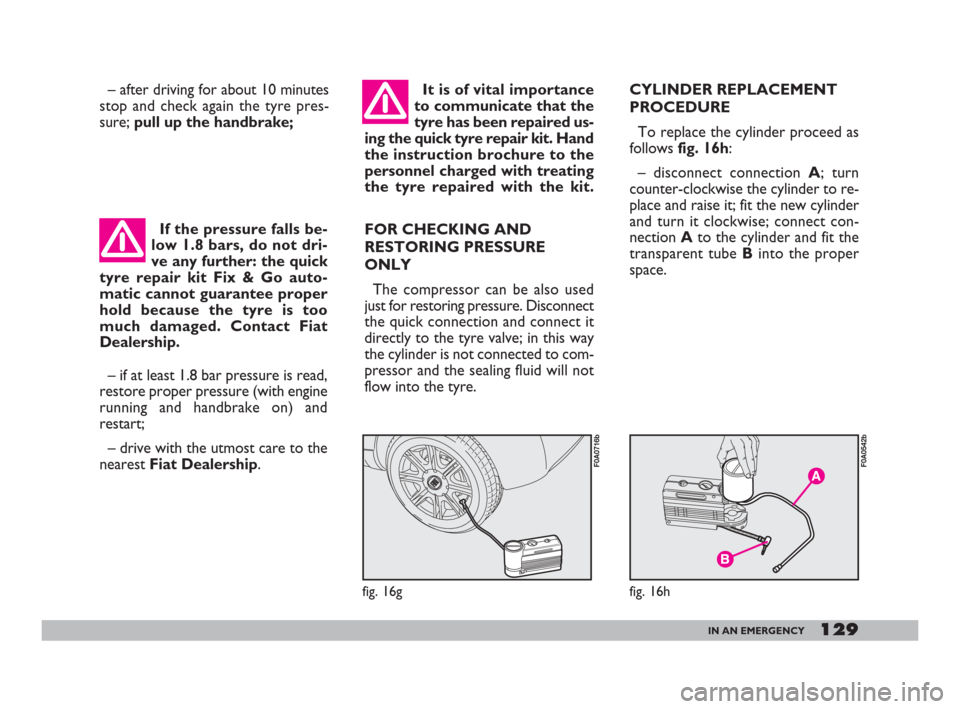
If the pressure falls be-
low 1.8 bars, do not dri-
ve any further: the quick
tyre repair kit Fix & Go auto-
matic cannot guarantee proper
hold because the tyre is too
much damaged. Contact Fiat
Dealership.
– if at least 1.8 bar pressure is read,
restore proper pressure (with engine
running and handbrake on) and
restart;
– drive with the utmost care to the
nearest Fiat Dealership.
129IN AN EMERGENCY
– after driving for about 10 minutes
stop and check again the tyre pres-
sure; pull up the handbrake;It is of vital importance
to communicate that the
tyre has been repaired us-
ing the quick tyre repair kit. Hand
the instruction brochure to the
personnel charged with treating
the tyre repaired with the kit.
FOR CHECKING AND
RESTORING PRESSURE
ONLY
The compressor can be also used
just for restoring pressure. Disconnect
the quick connection and connect it
directly to the tyre valve; in this way
the cylinder is not connected to com-
pressor and the sealing fluid will not
flow into the tyre. CYLINDER REPLACEMENT
PROCEDURE
To replace the cylinder proceed as
follows fig. 16h:
– disconnect connectionA; turn
counter-clockwise the cylinder to re-
place and raise it; fit the new cylinder
and turn it clockwise; connect con-
nection Ato the cylinder and fit the
transparent tube Binto the proper
space.
fig. 16g
F0A0716b
fig. 16h
F0A0542b
119-148 Doblo GB 9-05-2008 12:09 Pagina 129
Page 152 of 222
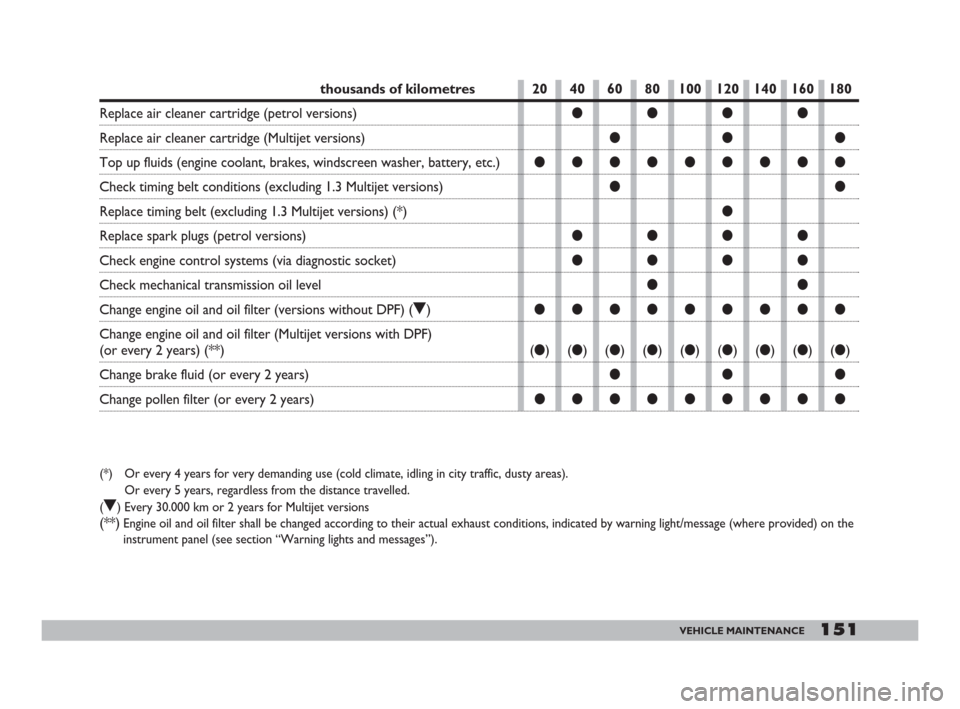
151VEHICLE MAINTENANCE
20 40 60 80 100 120 140 160 180
●●●●
●●●
●●●●●●●●●
●●
●
●●●●
●●●●
●●
●●●●●●●●●
(●)(●)(●)(●)(●)(●)(●)(●)(●)
●●●
●●●●●●●●●thousands of kilometres
Replace air cleaner cartridge (petrol versions)
Replace air cleaner cartridge (Multijet versions)
Top up fluids (engine coolant, brakes, windscreen washer, battery, etc.)
Check timing belt conditions (excluding 1.3 Multijet versions)
Replace timing belt (excluding 1.3 Multijet versions) (*)
Replace spark plugs (petrol versions)
Check engine control systems (via diagnostic socket)
Check mechanical transmission oil level
Change engine oil and oil filter (versions without DPF) (O)
Change engine oil and oil filter (Multijet versions with DPF)
(or every 2 years) (**)
Change brake fluid (or every 2 years)
Change pollen filter (or every 2 years)
(*) Or every 4 years for very demanding use (cold climate, idling in city traffic, dusty areas).
Or every 5 years, regardless from the distance travelled.
(
O) Every 30.000 km or 2 years for Multijet versions
(**)Engine oil and oil filter shall be changed according to their actual exhaust conditions, indicated by warning light/message (where provided) on the
instrument panel (see section “Warning lights and messages”).
149-173 Doblo GB 9-05-2008 12:10 Pagina 151
Page 153 of 222
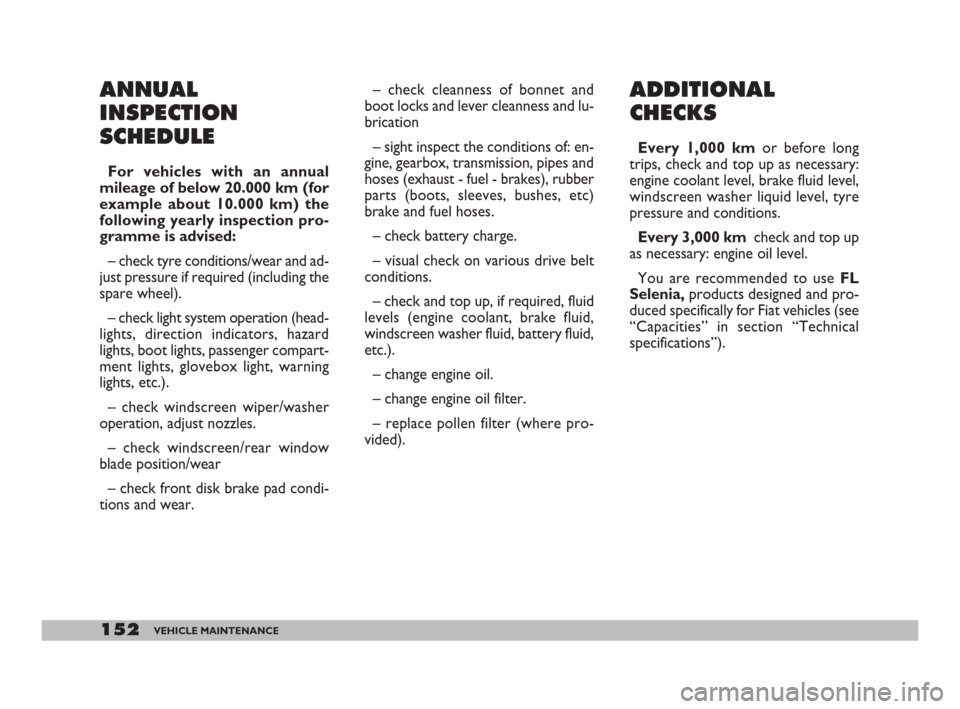
152VEHICLE MAINTENANCE
ANNUAL
INSPECTION
SCHEDULE
For vehicles with an annual
mileage of below 20.000 km (for
example about 10.000 km) the
following yearly inspection pro-
gramme is advised:
– check tyre conditions/wear and ad-
just pressure if required (including the
spare wheel).
– check light system operation (head-
lights, direction indicators, hazard
lights, boot lights, passenger compart-
ment lights, glovebox light, warning
lights, etc.).
– check windscreen wiper/washer
operation, adjust nozzles.
– check windscreen/rear window
blade position/wear
– check front disk brake pad condi-
tions and wear.– check cleanness of bonnet and
boot locks and lever cleanness and lu-
brication
– sight inspect the conditions of: en-
gine, gearbox, transmission, pipes and
hoses (exhaust - fuel - brakes), rubber
parts (boots, sleeves, bushes, etc)
brake and fuel hoses.
– check battery charge.
– visual check on various drive belt
conditions.
– check and top up, if required, fluid
levels (engine coolant, brake fluid,
windscreen washer fluid, battery fluid,
etc.).
– change engine oil.
– change engine oil filter.
– replace pollen filter (where pro-
vided).
ADDITIONAL
CHECKS
Every 1,000 kmor before long
trips, check and top up as necessary:
engine coolant level, brake fluid level,
windscreen washer liquid level, tyre
pressure and conditions.
Every 3,000 km check and top up
as necessary: engine oil level.
You are recommended to use FL
Selenia,products designed and pro-
duced specifically for Fiat vehicles (see
“Capacities” in section “Technical
specifications”).
149-173 Doblo GB 9-05-2008 12:10 Pagina 152
Page 154 of 222
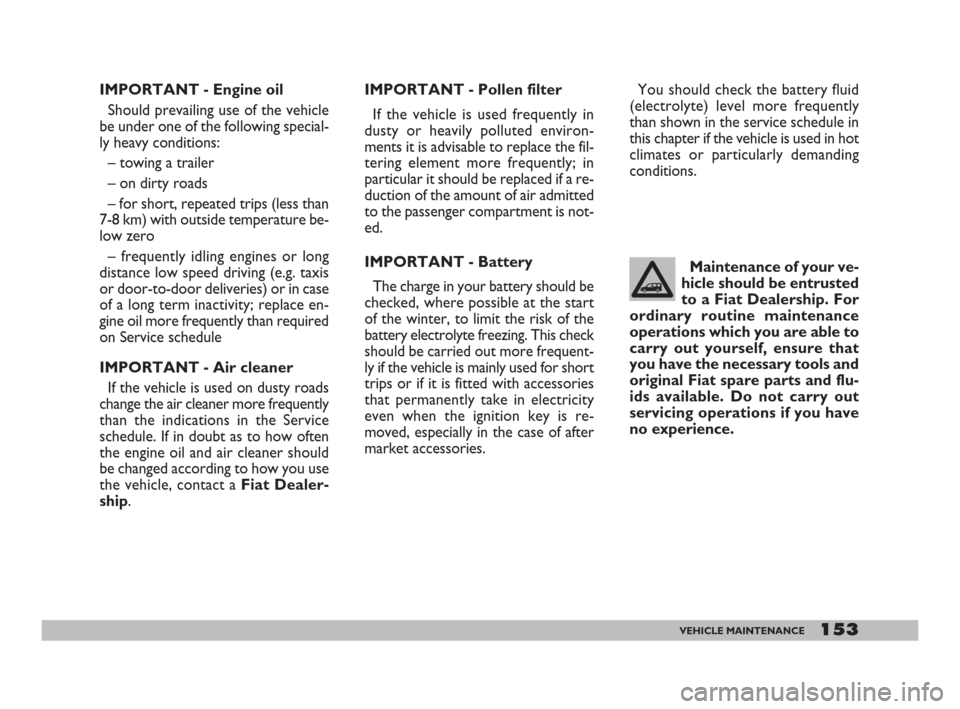
153VEHICLE MAINTENANCE
IMPORTANT - Engine oil
Should prevailing use of the vehicle
be under one of the following special-
ly heavy conditions:
– towing a trailer
– on dirty roads
– for short, repeated trips (less than
7-8 km) with outside temperature be-
low zero
– frequently idling engines or long
distance low speed driving (e.g. taxis
or door-to-door deliveries) or in case
of a long term inactivity; replace en-
gine oil more frequently than required
on Service schedule
IMPORTANT - Air cleaner
If the vehicle is used on dusty roads
change the air cleaner more frequently
than the indications in the Service
schedule. If in doubt as to how often
the engine oil and air cleaner should
be changed according to how you use
the vehicle, contact a Fiat Dealer-
ship.IMPORTANT - Pollen filter
If the vehicle is used frequently in
dusty or heavily polluted environ-
ments it is advisable to replace the fil-
tering element more frequently; in
particular it should be replaced if a re-
duction of the amount of air admitted
to the passenger compartment is not-
ed.
IMPORTANT - Battery
The charge in your battery should be
checked, where possible at the start
of the winter, to limit the risk of the
battery electrolyte freezing. This check
should be carried out more frequent-
ly if the vehicle is mainly used for short
trips or if it is fitted with accessories
that permanently take in electricity
even when the ignition key is re-
moved, especially in the case of after
market accessories.You should check the battery fluid
(electrolyte) level more frequently
than shown in the service schedule in
this chapter if the vehicle is used in hot
climates or particularly demanding
conditions.
Maintenance of your ve-
hicle should be entrusted
to a Fiat Dealership. For
ordinary routine maintenance
operations which you are able to
carry out yourself, ensure that
you have the necessary tools and
original Fiat spare parts and flu-
ids available. Do not carry out
servicing operations if you have
no experience.
149-173 Doblo GB 9-05-2008 12:10 Pagina 153
Page 155 of 222
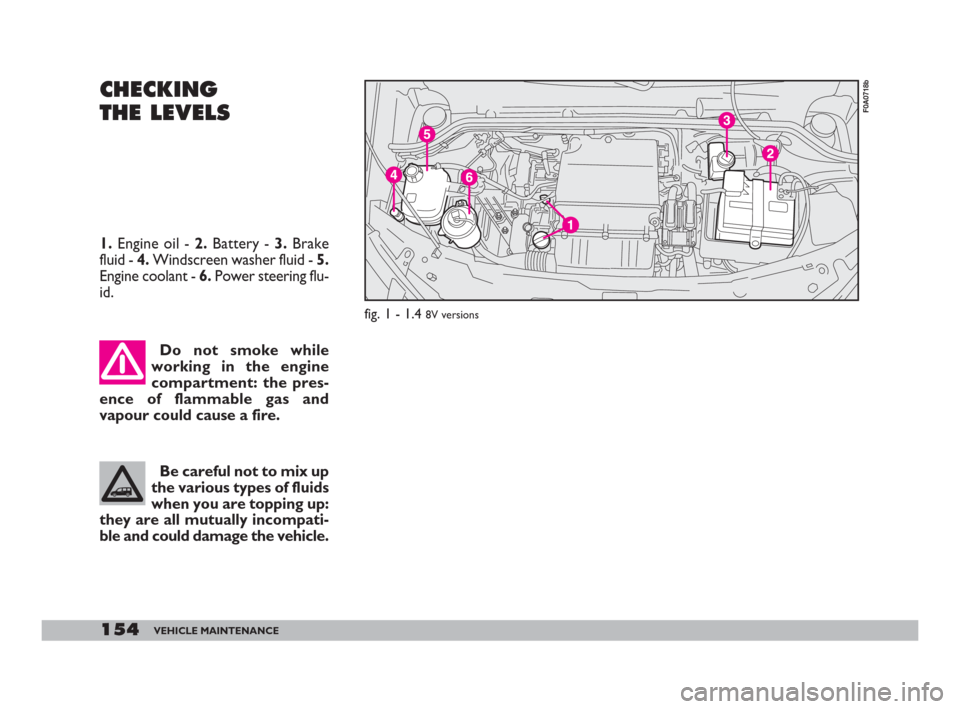
154VEHICLE MAINTENANCE
CHECKING
THE LEVELS
Do not smoke while
working in the engine
compartment: the pres-
ence of flammable gas and
vapour could cause a fire.
Be careful not to mix up
the various types of fluids
when you are topping up:
they are all mutually incompati-
ble and could damage the vehicle.
1.Engine oil - 2.Battery - 3.Brake
fluid - 4.Windscreen washer fluid - 5.
Engine coolant - 6.Power steering flu-
id.
F0A0718b
fig. 1 - 1.4 8V versions
149-173 Doblo GB 9-05-2008 12:10 Pagina 154
Page 158 of 222
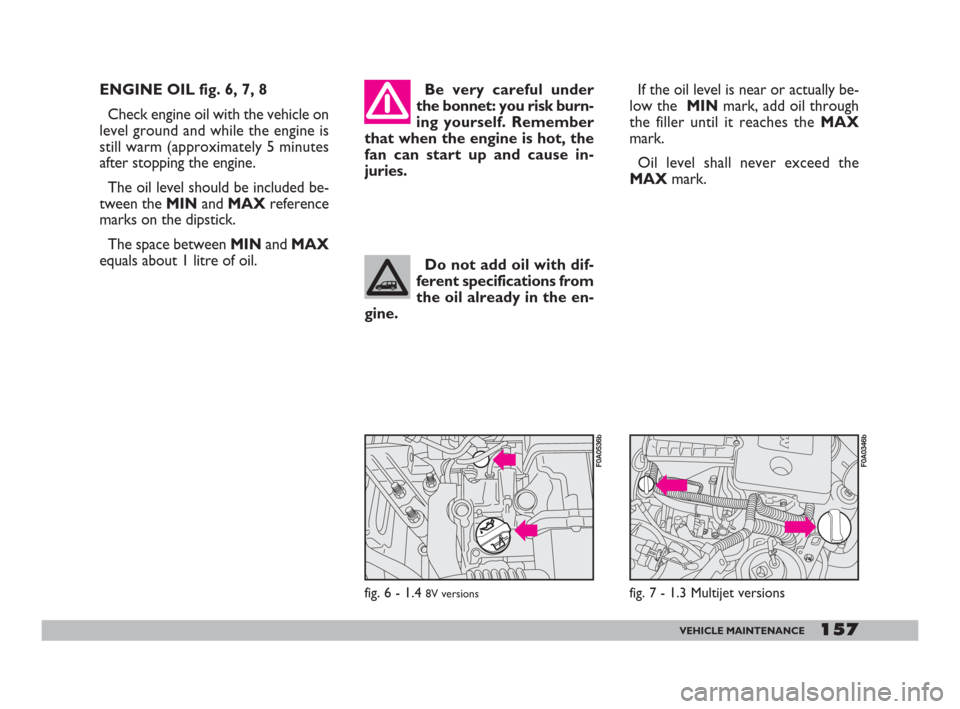
157VEHICLE MAINTENANCE
ENGINE OIL fig. 6, 7, 8
Check engine oil with the vehicle on
level ground and while the engine is
still warm (approximately 5 minutes
after stopping the engine.
The oil level should be included be-
tween the MINand MAXreference
marks on the dipstick.
The space between MINand MAX
equals about 1 litre of oil.If the oil level is near or actually be-
low the MINmark, add oil through
the filler until it reaches the MAX
mark.
Oil level shall never exceed the
MAXmark. Be very careful under
the bonnet: you risk burn-
ing yourself. Remember
that when the engine is hot, the
fan can start up and cause in-
juries.
Do not add oil with dif-
ferent specifications from
the oil already in the en-
gine.
fig. 6 - 1.4 8V versions
F0A0536bF0A0346b
fig. 7 - 1.3 Multijet versions
149-173 Doblo GB 9-05-2008 12:10 Pagina 157